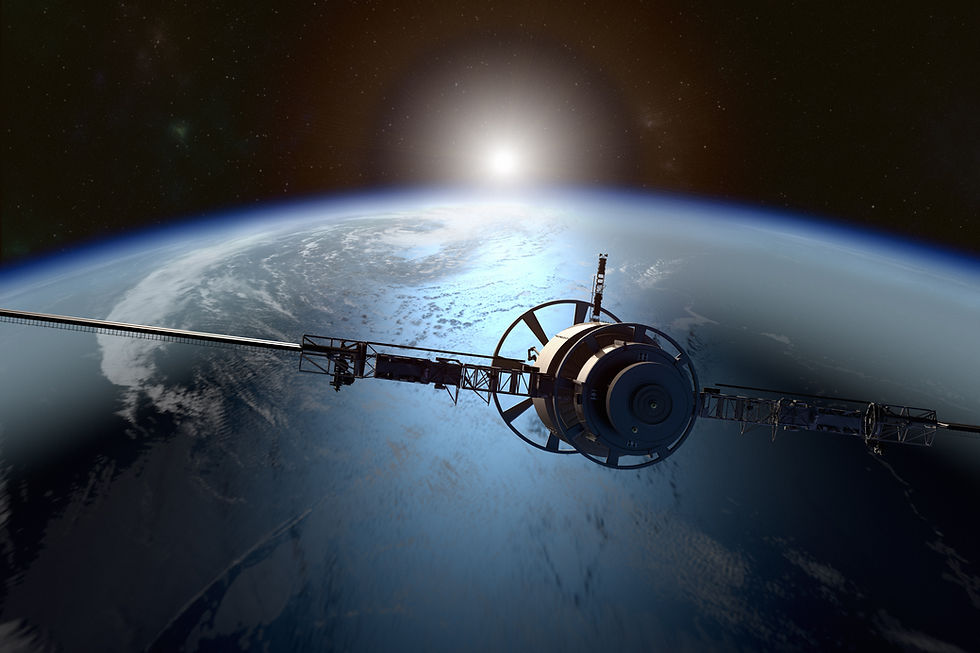A Year in Space: 2024
- Riyam Ojaimi

- Dec 27, 2024
- 5 min read
2024 Space Rewind: A Year of Discovery and Innovation
As we bid farewell to 2024, it’s time to reflect on the groundbreaking discoveries and innovations that have propelled humanity’s understanding of the cosmos forward. This year has been nothing short of extraordinary, marked by new astrophysical insights, technological advancements, and ambitious space missions that have reshaped our grasp of the universe. Let’s dive into the key milestones that defined 2024 in space exploration and science, we've got 7 things listed!
1. The James Webb Space Telescope (JWST): A Universe in High Definition
The James Webb Space Telescope continued to unveil the universe’s secrets in 2024 with unprecedented clarity. Among its most notable achievements this year was the detection of carbon-based molecules, including methyl cations, in the atmospheres of exoplanets within the TRAPPIST-1 system. These findings are crucial steps in the quest to identify potentially habitable worlds, as methyl cations are considered precursors to more complex organic molecules essential for life.

Additionally, JWST captured the earliest-known galaxy cluster, dating back nearly 13.2 billion years, shedding light on the processes that governed the formation of galaxies shortly after the Big Bang. These images revealed intricate details of star formation and galactic mergers, enhancing our understanding of the early universe’s chaotic environment.
JWST also observed dynamic changes in distant stars and planetary systems, allowing astronomers to witness stellar birth and death in real-time. Its unprecedented resolution has made it the most effective tool for probing the universe’s distant past and complex present.
2. A New Era of Spaceflight
2024 witnessed several milestones in human and robotic space exploration:
Artemis II Prepares for Liftoff
NASA’s Artemis II mission, set to carry astronauts around the Moon in 2025, reached critical milestones in 2024. The spacecraft’s Orion capsule underwent rigorous environmental and thermal vacuum testing, ensuring it could withstand the harsh conditions of deep space. Engineers also completed final integration with the Space Launch System (SLS) rocket, verifying the system's compatibility and performance.
Additionally, simulations of crewed flight scenarios were conducted to address potential challenges, such as emergency protocols and communication delays. These advancements mark significant progress in preparing for the mission, which aims to establish the foundation for sustained human exploration of the Moon. The spacecraft’s Orion capsule underwent rigorous environmental and thermal vacuum testing to ensure its readiness for deep-space travel. Engineers also completed final integration with the Space Launch System (SLS) rocket, the most powerful launch vehicle ever built. These developments bring humanity closer to establishing a sustainable presence on the Moon.

Starship’s Orbital Success in Space
SpaceX’s Starship achieved its first fully successful orbital flight in 2024. This mission demonstrated the vehicle’s reusability, with both the booster and upper stage completing safe landings. Starship’s ability to transport over 100 metric tons of cargo to orbit and beyond makes it a cornerstone of future Mars missions and deep-space exploration. It also successfully deployed multiple satellite constellations, showcasing its versatility.
3. Breakthroughs in Exoplanet Science
2024 has been a banner year for exoplanetary research. Highlights include:
TOI-456b: A Potential Ocean World: Astronomers using the Transiting Exoplanet Survey Satellite (TESS) confirmed TOI-456b as an ocean world, with extensive water coverage and a dense atmosphere rich in hydrogen and nitrogen. These conditions, combined with its location in the habitable zone of its star, make it a prime candidate for astrobiological studies. Follow-up observations by JWST hinted at seasonal atmospheric changes, possibly driven by oceanic activity.
The Habitable Exoplanet Observatory (HabEx): The newly operational HabEx observatory deployed a next-generation coronagraph, enabling direct imaging of exoplanets in unprecedented detail. Scientists captured high-resolution images of several Earth-sized exoplanets, observing atmospheric compositions indicative of potential habitability. HabEx’s capabilities have transformed our ability to study these distant worlds.

4. Astrophysics: Decoding the Cosmos
Gravitational Wave Astronomy
The LIGO-Virgo-KAGRA collaboration recorded over 100 new gravitational wave events in 2024, including the detection of a triple black hole merger. These findings have expanded our understanding of black hole dynamics and stellar evolution. Moreover, improved detectors allowed for more precise localisation of gravitational wave sources, enabling follow-up electromagnetic observations. Data from neutron star mergers also provided critical insights into the formation of heavy elements like gold and platinum, as well as refined measurements of the universe’s expansion rate (the Hubble constant). This ongoing research addresses one of cosmology’s most pressing challenges: the discrepancy between different methods of measuring the Hubble constant.
Dark Matter Mapping
The Dark Energy Spectroscopic Instrument (DESI) released the most detailed 3D map of dark matter distribution to date, covering over 40% of the observable universe. This map revealed intricate filaments connecting galaxy clusters and provided evidence for the role of dark matter in shaping the universe’s structure. These findings are expected to refine theoretical models of dark matter particle behaviour and interaction.

5. Innovations in Space Technology
2024 also saw technological advancements that will shape the future of space exploration:
Nuclear Thermal Propulsion (NTP): A New Frontier: NASA’s successful test of a nuclear thermal propulsion system demonstrated its potential to revolutionise interplanetary travel. By using nuclear fission to heat hydrogen propellant, NTP systems offer higher efficiency and faster transit times compared to conventional chemical rockets. This technology could reduce Mars mission durations by up to 30%, significantly enhancing crew safety and mission feasibility.
Orbital Debris Management: Private companies unveiled satellite designs featuring self-deorbiting mechanisms, including onboard ion thrusters and biodegradable components. These innovations aim to mitigate the growing issue of space debris, ensuring sustainable use of Earth’s orbital environment.
AI in Space Missions: Artificial intelligence played a pivotal role in optimising mission operations in 2024. ESA’s Euclid spacecraft employed AI to classify over a billion galaxies, accelerating the search for patterns in dark energy distribution. Similarly, autonomous systems onboard Mars rovers enhanced navigation and sample collection efficiency, reducing reliance on Earth-based commands.
6. Citizen Science and Public Engagement
2024 was a year of collaboration between scientists and the public. The Zooniverse platform engaged thousands of volunteers in identifying new gravitational lens candidates and categorising unusual light curves from TESS data. These contributions accelerated discoveries that might otherwise have taken years.
Public outreach campaigns, such as the International Astronomical Union’s "Name Exoworlds" initiative, invited people worldwide to propose names for newly discovered planets and their host stars. This initiative fostered global interest in astronomy and highlighted the shared nature of space exploration.
7. Looking Ahead: The Future of Space Exploration
As we close the chapter on 2024, the roadmap for the years ahead is exhilarating. The European Space Agency’s JUICE mission, set to explore Jupiter’s moons Ganymede, Callisto, and Europa, promises groundbreaking insights into subsurface oceans and their potential for life. NASA’s Dragonfly mission to Titan, launching in 2027, made significant preparatory strides this year, including testing drone flight capabilities in simulated Titan conditions. Meanwhile, advancements in space manufacturing - including 3D printing of habitats using lunar regolith - offer a glimpse into humanity’s future as an interplanetary species. These developments underscore the importance of continued innovation and collaboration in shaping our cosmic destiny.
Conclusion
2024 has demonstrated that humanity’s curiosity and ingenuity know no bounds. From deciphering the universe’s origins to pushing the limits of technology, this year has been a testament to our relentless drive to explore and understand. As we turn our gaze to 2025, we carry forward the discoveries and innovations of 2024 as stepping stones to a brighter, more interconnected future in the cosmos!
Happy holidays and new year,
Riyam Ojaimi




.png)
Comments